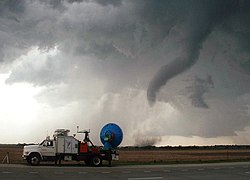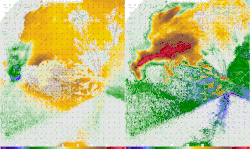Doppler on Wheels



Doppler on Wheels(orDOW) is a fleet ofX-bandandC-bandmobile and quickly-deployable truck-borneradarswhich are the core instrumentation of the Flexible Array of Radars and Mesonets[1]affiliated with theUniversity of Illinois[2]and led byJoshua Wurman,with the funding partially provided by theNational Science Foundation(NSF), as part of the "Community Instruments and Facilities," (CIF) program. The DOW fleet and its associated MobileMesonetsand deployable weather stations (PODs & Polenet) have been used throughout the United States since 1995, as well as occasionally in Europe and Southern America.[1]The Doppler on Wheels network has deployed itself through hazardous and challenging weather to gather data and information that may be missed by conventional stationary radar systems.
History
[edit]The first DOW platform was created and deployed in 1995, substantially changing the design paradigm of targeted meteorological studies. Ground-breaking, extremely fine-scale data was collected intornadoes[3]andhurricanes,[4]as well as other phenomena. DOWs, by virtue of providing especially fine-scale targeted observations, have been central to various scientific discoveries, "firsts", and pioneering observations, e.g. the first concrete documentation of specific impacts of weather modification cloud seeding, the first mapping of multiple-vortices in tornadoes, the quantification of tornado low-level wind structure, etc. The DOW program rapidly expanded and evolved to include the first mobile dual-Doppler radarnetwork, the first mobile rapid-scan radar (the Rapid-Scan DOW, RSDOW),[1]and the first quickly-deployable 1-degree C-band radar, the C-band on Wheels (COW). The DOWs, Mobile Mesonets, PODs & POLEs, as well as many other devices were crucial for instrumentation in numerous field projects, includingVORTEX,VORTEX2,COPS, MAP, ASCII, IHOP, SCMS, CASES, ROTATE, PAMREX, SNOWD-UNDER, FLATLAND, HERO, UIDOW, UNDEO[citation needed],LEE, PERILS,[5]WINTRE-MIX,[6]RELAMPAGO,[7]GRAINEX,[8]and others.
In late 2018, the DOW Facility debuted a new quickly-deployable C-band radar (or COW) featuring a larger antenna and 5cm wavelength (as compared to the 3cm wavelength of the DOWs). Due to the larger size of the antenna, the truck features a built-in crane allowing for the radar to be assembled on site. The COW was first deployed as part of the RELAMPAGO field campaign in Argentina in late 2018.[9]
The DOW fleet has collected data in 250 tornadoes and inside the cores of eighteen hurricanes. DOWs have been deployed to Europe twice,[10]for the MAP and COPS field programs, and toAlaskatwice for the JAWS-Juneau projects, and to South America for RELAMPAGO. DOWs have operated as high as 12,700 feet (3,900 m) onBristol Headand at 10,000 feet (3,000 m) for the ASCII project atBattle Pass.
The DOW fleet, PODS, and Mobile Mesonets have been featured on television, includingDiscovery Channel's seriesStorm Chasers(joined by theTornado Intercept Vehiclesand theDominator SRVvehicles),[11]National Geographic Channel's specialsTornado InterceptandThe True Face of Hurricanes,andPBS'sNovaepisode "The Hunt for the Supertwister," and others.[citation needed]
Capabilities
[edit]As of May 2024, the current operational Doppler on Wheels vehicles include the CROW (which consists of the DOW8/RSDOW/Mini-COW)[12],and the COW (C-band On Wheels, occasionally referred to as the COW1).
The COW consists of a C-band dual-polarization dual-frequency radar system utilizing two 1 MW transmitters set to a 5cm wavelength configuration.[13]The CROW consists of three separate configurations, the DOW8, which utilizes a single-polarization 250 kW X-band transmitter, the RSDOW, which consists of a 7-second rapid-scan passive phased array antenna, utilizing a TWT 40 kW X-band transmitter system,[14]and the Mini-COW, utilizing a singular 1 MW C-band transmitter capable of 50-second dual-polarization updates.[12]
As of May 2024, the DOW6 and DOW7 are currently undergoing overhauls with new equipment, including the vehicles themselves, the transmitters, and the computing systems, as well as the integration with the new GURU software.[12]The previous iterations of the DOW6 and DOW7 utilized dual-polarization dual-frequency 250 KW X-band transmitters, and were the most powerful mobile X-band systems at the time.
DOWs are frequently deployed with the tightly integrated surface instrumentation network of the FARM.[13]Several instrumented mobile mesonet pickup trucks hostin situweather instrumentationon 3.5-metre (11 ft) masts to complement theremote sensingradars. These mobile mesonets also carry approximately twenty instrumented "PODS", which are ruggedized quickly deployableweather stationsdesigned to survive inside tornadoes, tropical cyclones, and other adverse environments, and a Polenet comprising instrumentation deployed on poles, railings, fences, etc. during hurricanelandfalls.An array of up to seven upper air and swarm sounding systems can also be deployed with the DOWs. The DOW fleet is sometimes accompanied by a Mobile Operations and Repair Center (MORC), a large van containing workstations for in-field coordination, data management, and equipment repair.[15]
Findings
[edit]DOW data led to the discovery of sub-kilometer hurricane boundary layer rolls, which likely modulate wind damage and may play a key role inhurricane intensification.DOW data revealed some of the most intense tornadic winds ever recorded (theBridge Creek–Moore tornado,3 May 1999, theEl Reno tornado,31 May 2013, and theGreenfield, Iowa Tornado,21 May 2024),[16][17]and the largest tornadic circulation ever documented (theCimarron City–Mulhall–Perry Tornado,which also occurred on 3 May, 1999),[18]and made the first 3D maps of tornado winds and sub-tornadic vortex winds, and documented intense vortices withinlake-effect snowbands. About 70 peer reviewed scientific publications have used DOW data.[citation needed]
DOW data has led to the discovery ofthe descending reflectivity core,a microscale phenomenon that may aid in tornadogenesis.
Future instrumentation
[edit]There are currently two major projects planned to expand the FARM's capabilities. The first is the creation of anS-bandon Wheels Network (SOWNET) featuring four quickly-deployable S-band radars with 10 cm wavelengths capable of seeing through intense precipitation. These smaller truck-mounted radars would replace a single large S-band radar, allowing for dual-Doppler analyses and quicker deployment times. The second planned project is theBistaticAdaptable Radar Network (BARN) which will be integrated with existing DOWs and the COW to provide high resolution wind vector observations without the need for multiple, expensive transmitters. These bistatic receivers will consist of small antennas that can be deployed like Pods or mounted onto a Mobile Mesonet or similar vehicle.[19]
See also
[edit]References
[edit]- ^abc"FARM: The DOW Network".farm.atmos.illinois.edu.Retrieved25 April2024.
- ^"Home | Department of Climate, Meteorology & Atmospheric Sciences | Illinois".atmos.illinois.edu.Retrieved25 April2024.
- ^Wurman, Joshua; Straka, Jerry M.; Rasmussen, Erik N. (1996)."Fine-Scale Doppler Radar Observations of Tornadoes".Science.272(5269): 1774–1777.Bibcode:1996Sci...272.1774W.doi:10.1126/science.272.5269.1774.PMID8662481.
- ^Wurman, Joshua; Winslow, Jennifer (1998)."Intense Sub-Kilometer-Scale Boundary Layer Rolls Observed in Hurricane Fran".Science.280(5363): 555–557.Bibcode:1998Sci...280..555W.doi:10.1126/science.280.5363.555.PMID9554839.
- ^"Next-generation storm forecasting project aims to save lives".NSF - National Science Foundation.8 February 2023.
- ^[1]
- ^Nesbitt, Stephen W.; et al. (2021)."A Storm Safari in Subtropical South America: Proyecto RELAMPAGO".Bulletin of the American Meteorological Society.102(8): E1621–E1644.Bibcode:2021BAMS..102E1621N.doi:10.1175/BAMS-D-20-0029.1.
- ^[2]
- ^Reppenhagen, Cory (4 December 2018)."New Colorado-designed 'Doppler on Wheels' chasing storms in Argentina".KUSA.Retrieved3 May2022.
Atmospheric scientists are excited about a new radar making its debut in Argentina. It's a Doppler on Wheels (DOW) built by the Center for Severe Weather Research in Boulder. [...] It is part of the RELAMPAGO project, studying severe storms in the Cordoba region of Argentina. A place where scientists believe some of the most intense storms on the planet form.
- ^Kouhestani, Jeanne; McGehan, Barbara; Tarp, Keli (14 October 1999)."NOAA SCIENTISTS, RESEARCH AIRCRAFT AND DOPPLER LIDAR JOIN MASSIVE WEATHER RESEARCH STUDY IN EUROPE"(Press Release). Archived fromthe originalon 11 December 2016.Retrieved3 May2022.
Scientists, a Doppler lidar, and a "hurricane hunter" aircraft from the National Oceanic and Atmospheric Administration have joined the largest weather research project ever conducted in Europe to study the effects on weather of wind flow over the Alps. Researchers from 11 nations hope to gain a better understanding of how this wind affects the weather, and to improve weather and river forecast models for mountainous areas, NOAA said today.
- ^"Doppler on Wheels | Storm Chasers | Discovery".Archived fromthe originalon 21 April 2017.Retrieved3 February2017.
- ^abc"FARM Updated Capabilities (including fully mobile mini-COW) 2023 AMS"(PDF).Retrieved6 May2024.
- ^abWurman, Joshua; Kosiba, Karen; Pereira, Brian; Robinson, Paul; Frambach, Andrew; Gilliland, Alycia; White, Trevor; Aikins, Josh; Trapp, Robert J.; Nesbitt, Stephen; Hanshaw, Maiana N.; Lutz, Jon (2021)."The Flexible Array of Radars and Mesonets (FARM)".Bulletin of the American Meteorological Society.102(8): E1499–E1525.Bibcode:2021BAMS..102E1499W.doi:10.1175/BAMS-D-20-0285.1.
- ^"FARM: The DOW Network".farm.atmos.illinois.edu.Retrieved6 May2024.
- ^"Observation".NOAA National Severe Storms Laboratory.
- ^Williams, Jack (17 May 2005)."Doppler radar measures 318 mph wind in tornado".USA Today.ISSN0734-7456.LCCNsn82006685.OCLC819006199.Archived fromthe originalon 16 October 2012.Retrieved3 May2022.
Scientists measured the fastest wind speed ever recorded, 318 mph, in one of the tornadoes that hit the suburbs of Oklahoma City on May 3, 1999. [...] The record-setting wind occurred about 7 p.m. near Moore, where the tornado killed four people and destroyed about 250 houses
- ^"As the 2024 #BEST field season ends, a glimpse into the data collection during the Greenfield, IA tornado. Peak wind speeds as high as 309-318 mph were calculated in a narrow region 100-160 feet ARL. These are among the highest wind speeds ever determined using DOW data".x.University of Illinois.22 June 2024.Retrieved22 June2024.
- ^"Rapid-Scanning Doppler on Wheels Keeps Pace with Twisters - News Release".Archived fromthe originalon 7 May 2013.Retrieved2 February2017.
- ^Wurman, Joshua; Kosiba, Karen (1 August 2021)."The Flexible Array of Radars and Mesonets (FARM)".Bulletin of the American Meteorological Society.102(8): E1499–E1525.Bibcode:2021BAMS..102E1499W.doi:10.1175/BAMS-D-20-0285.1.S2CID234827910.
